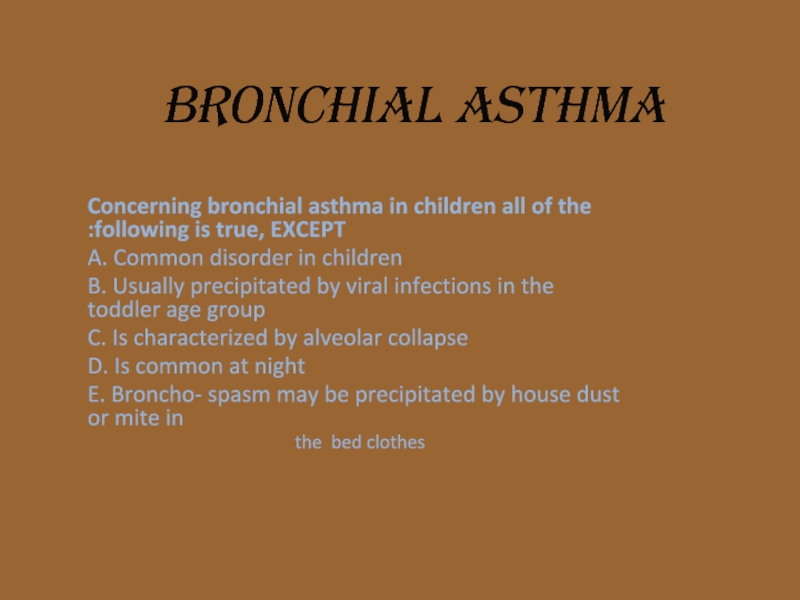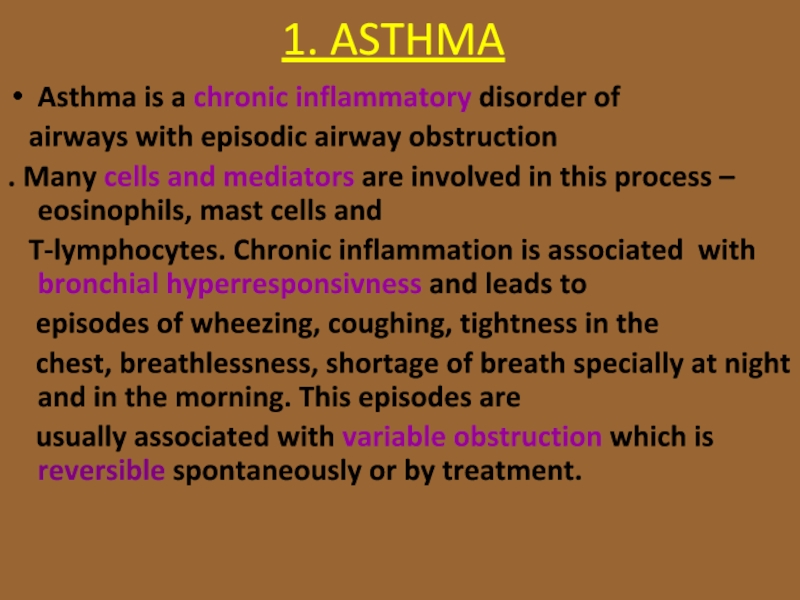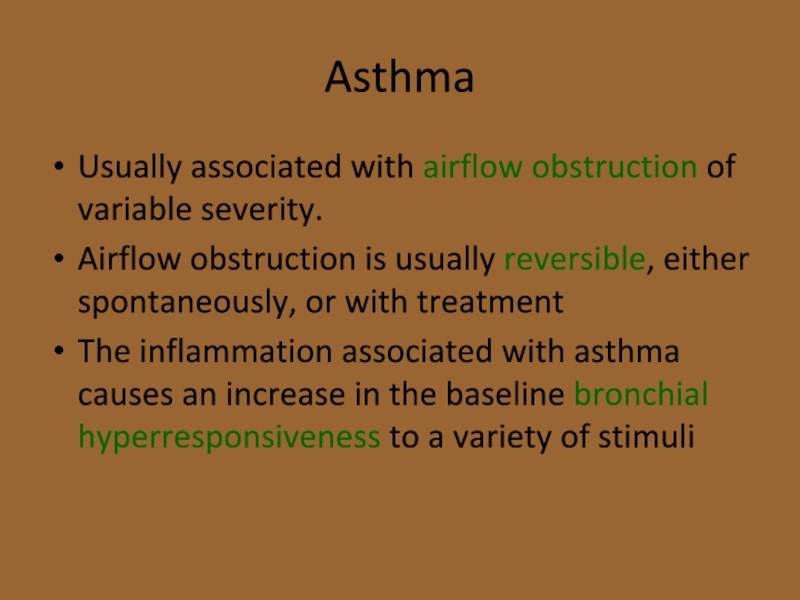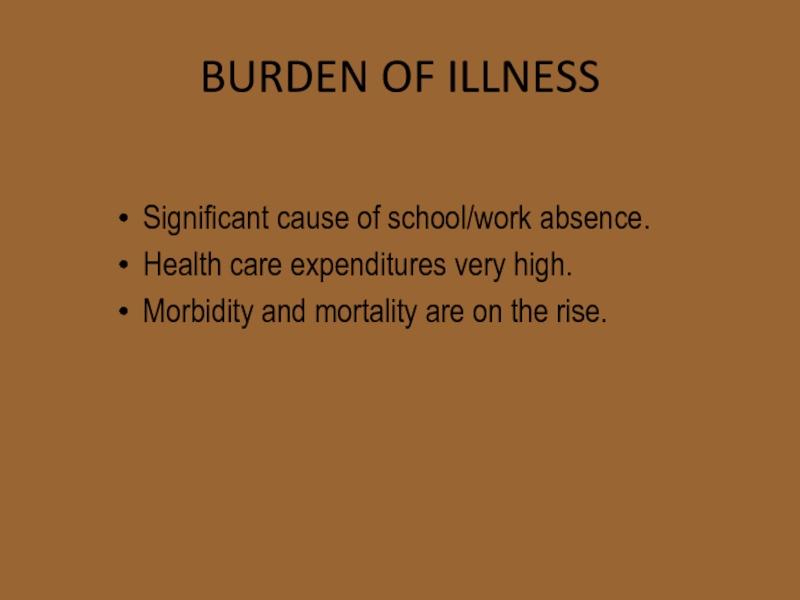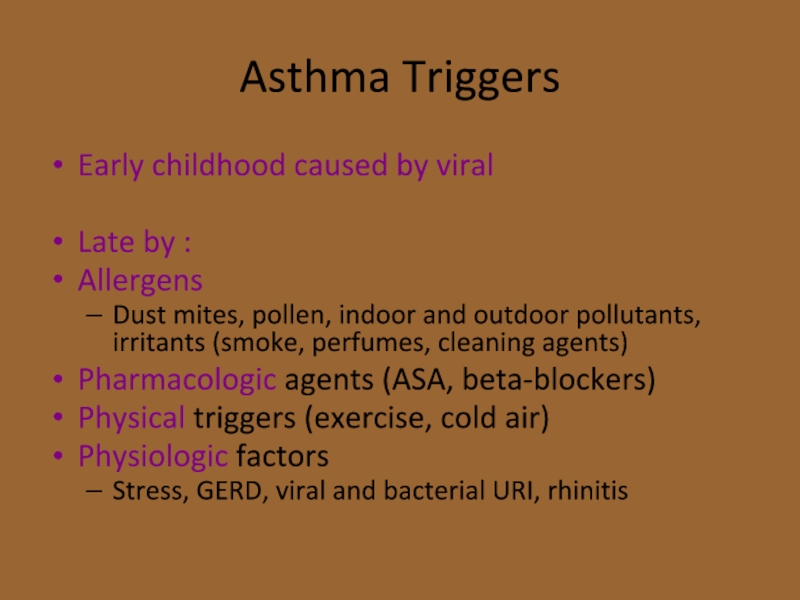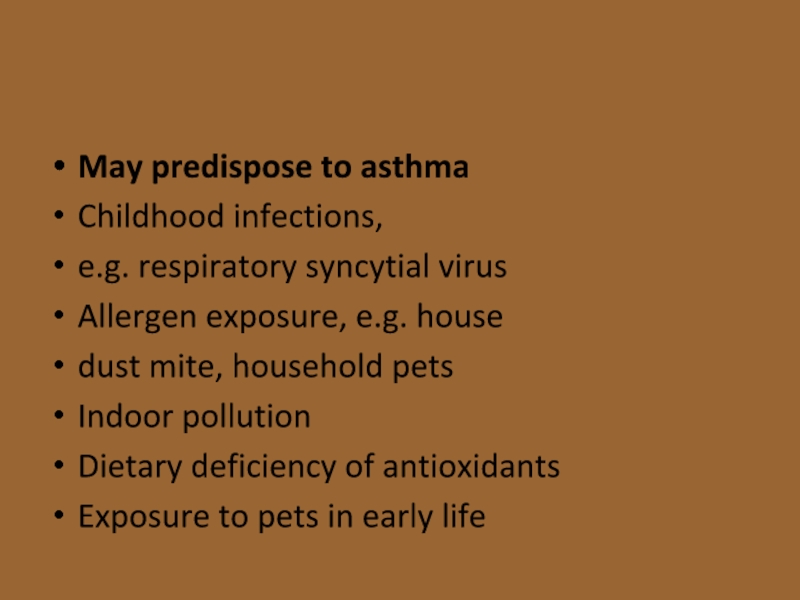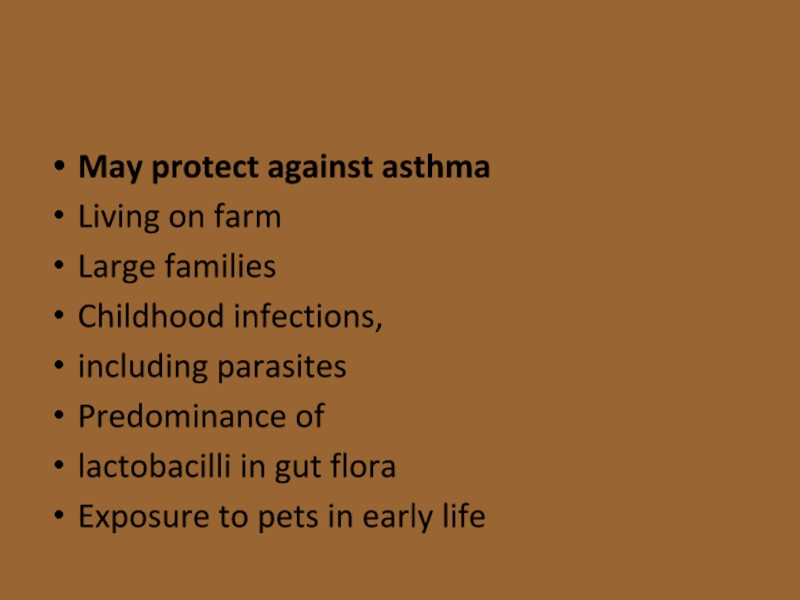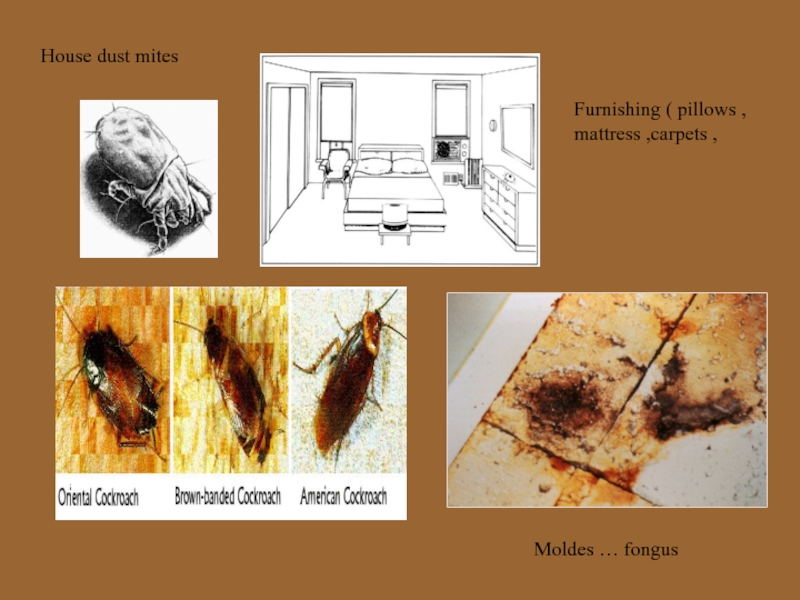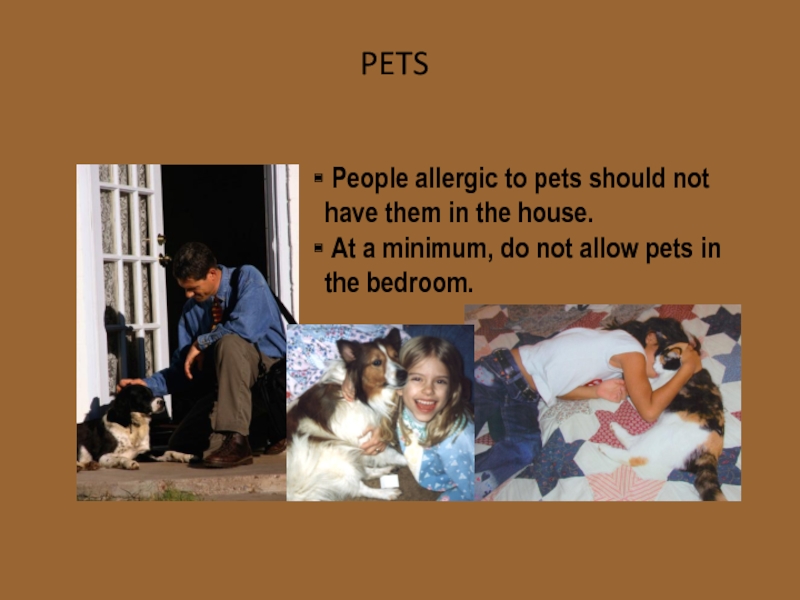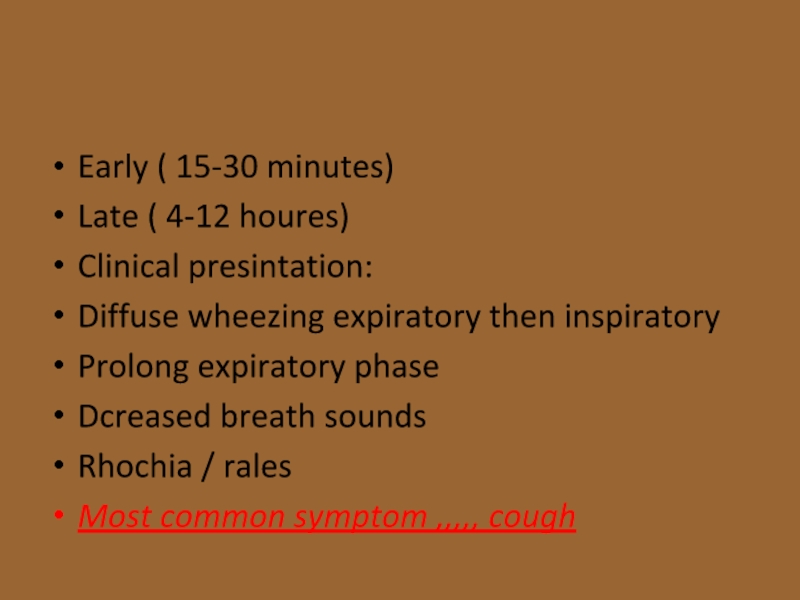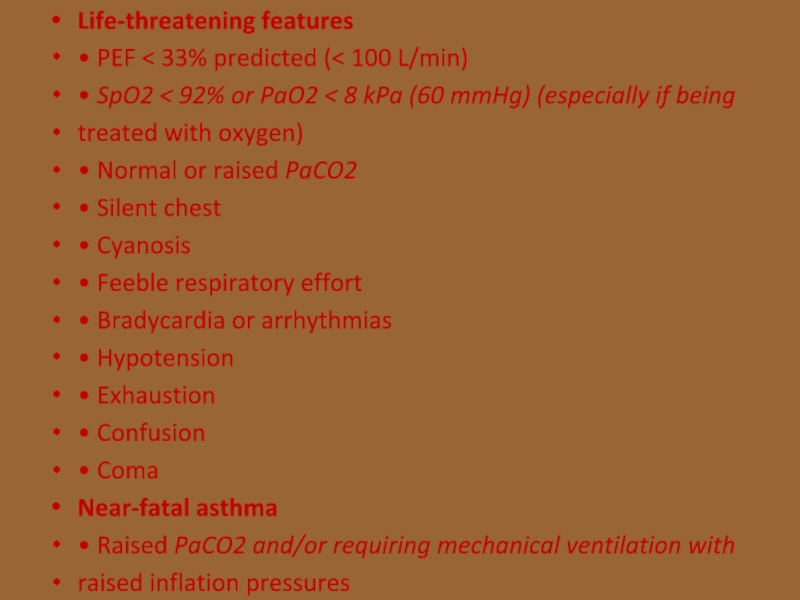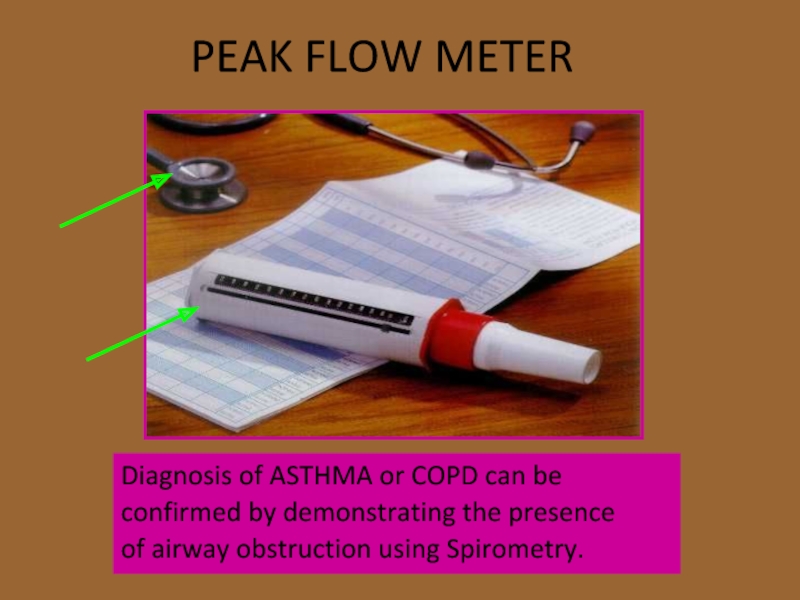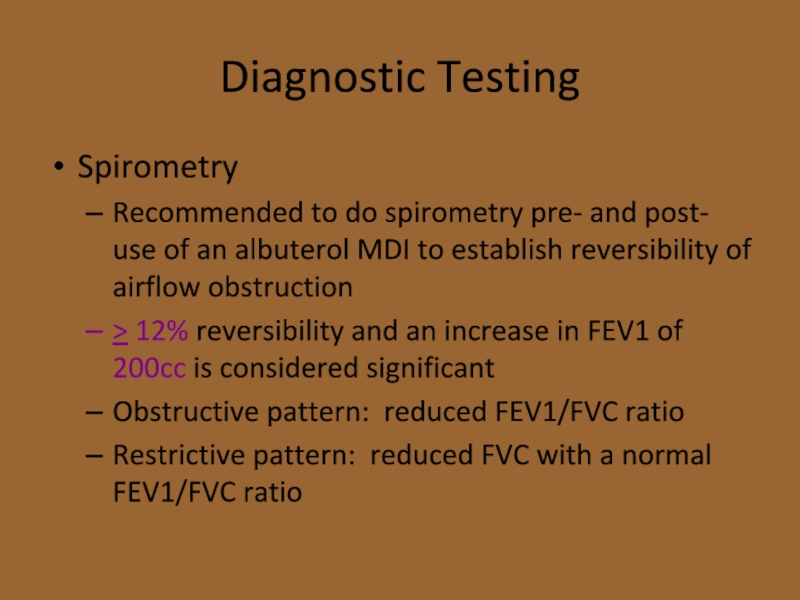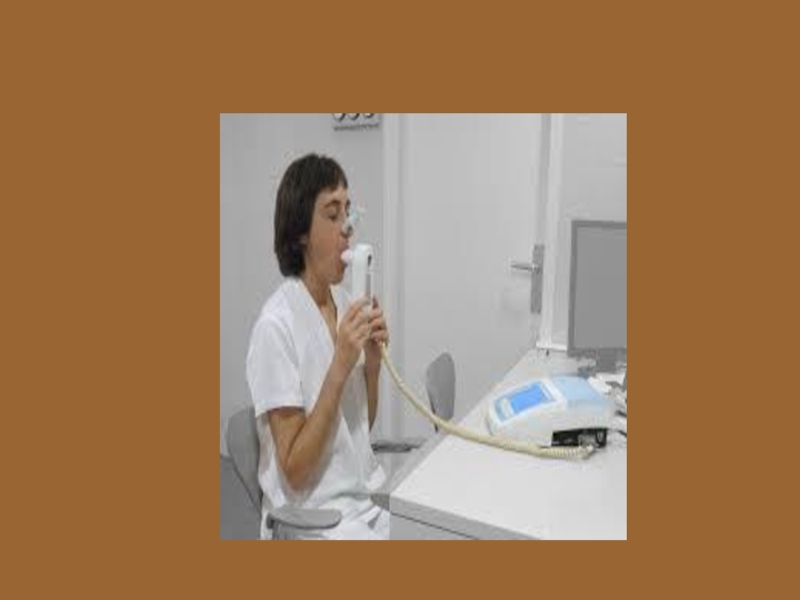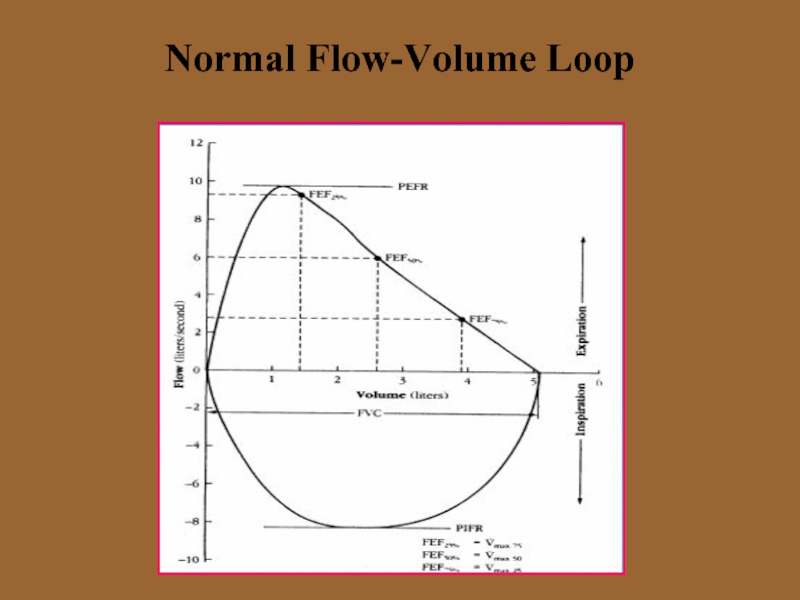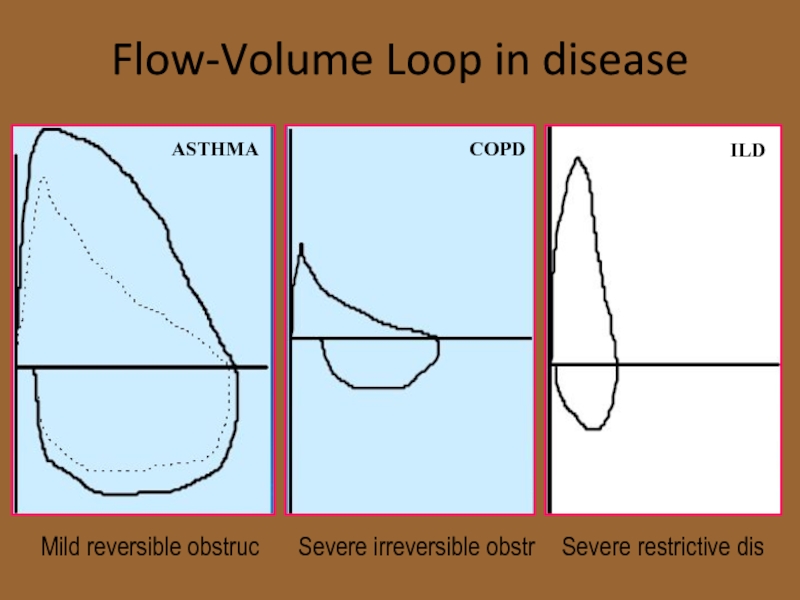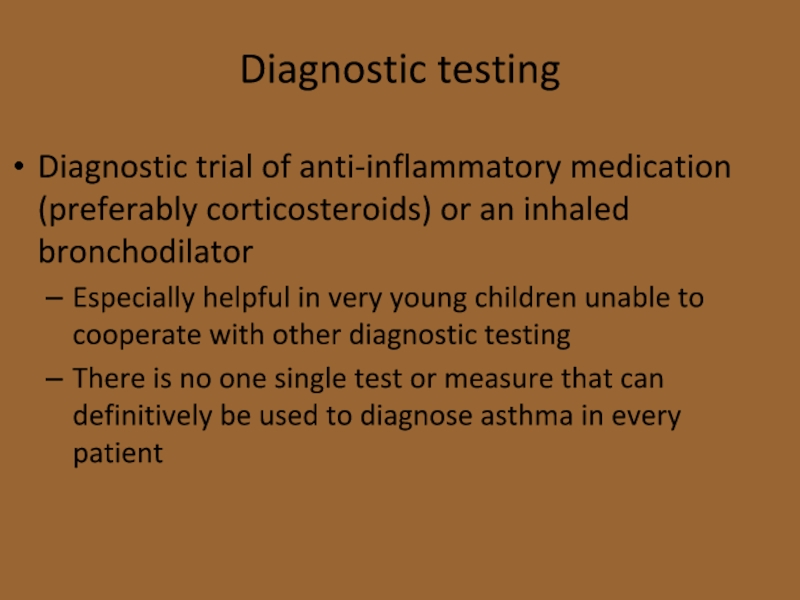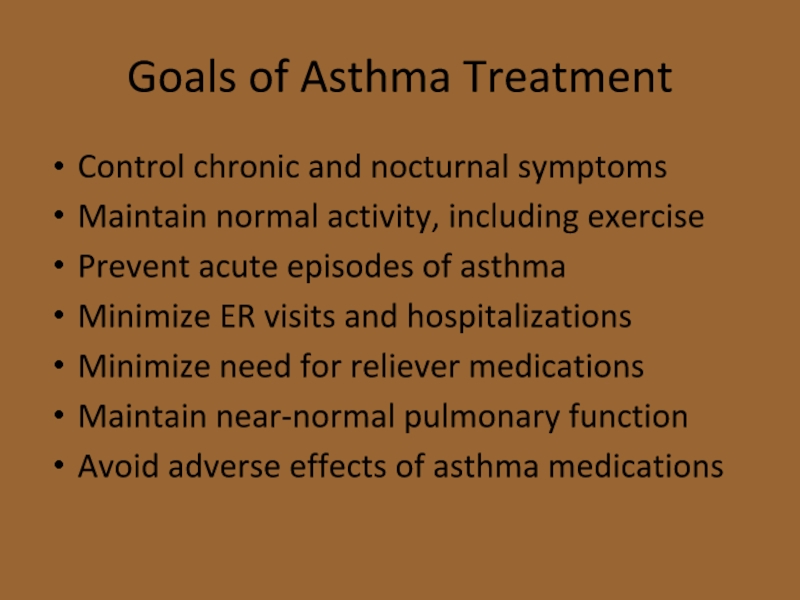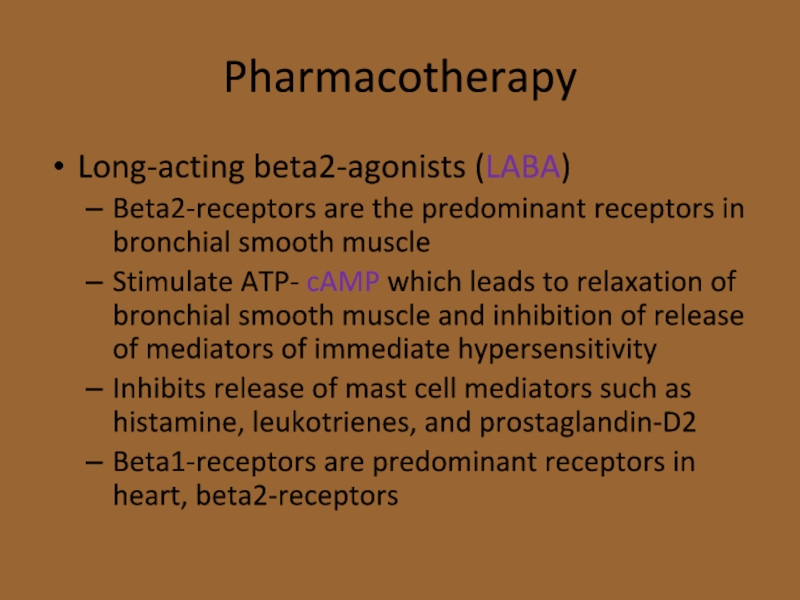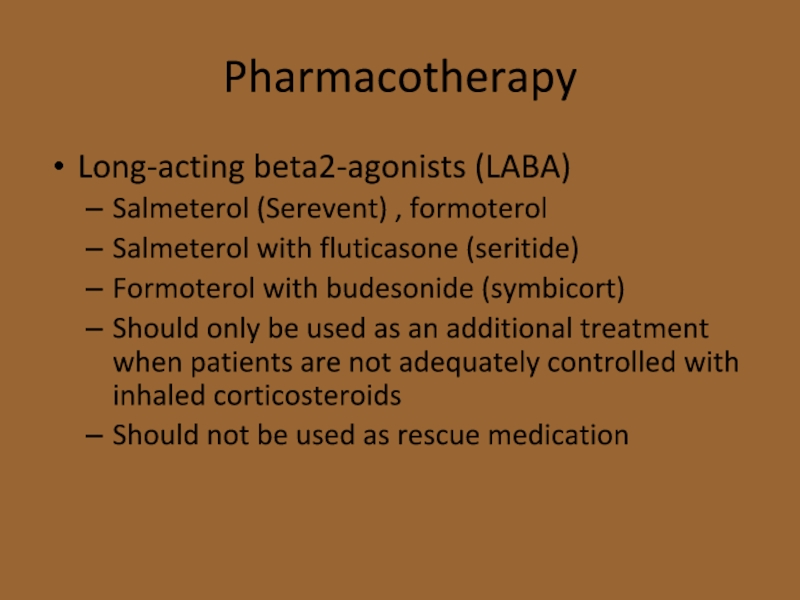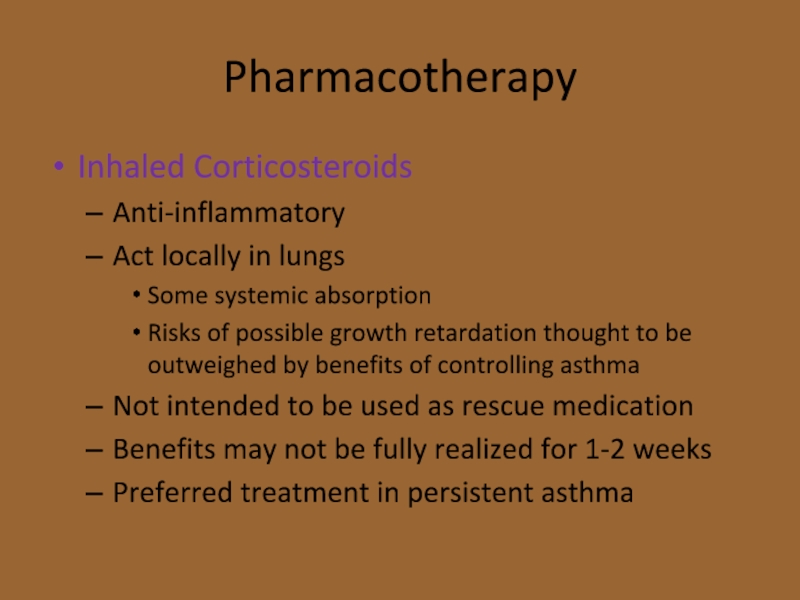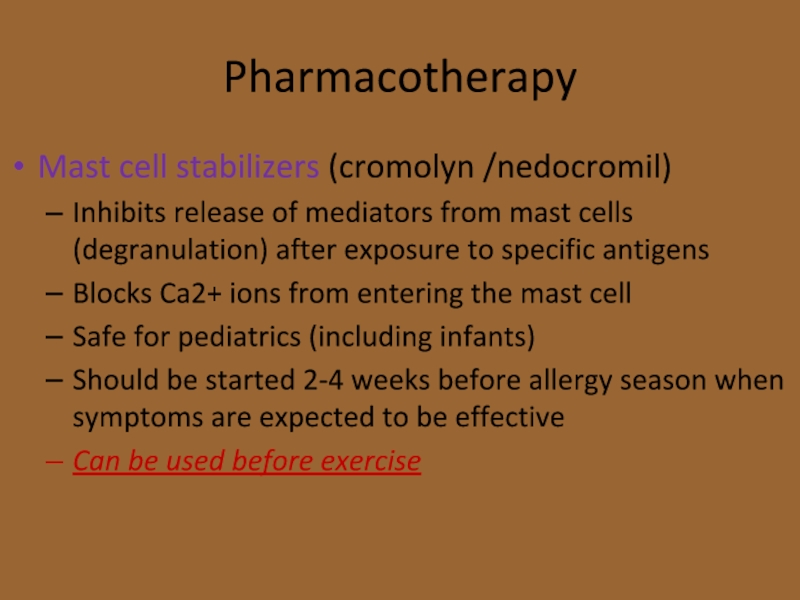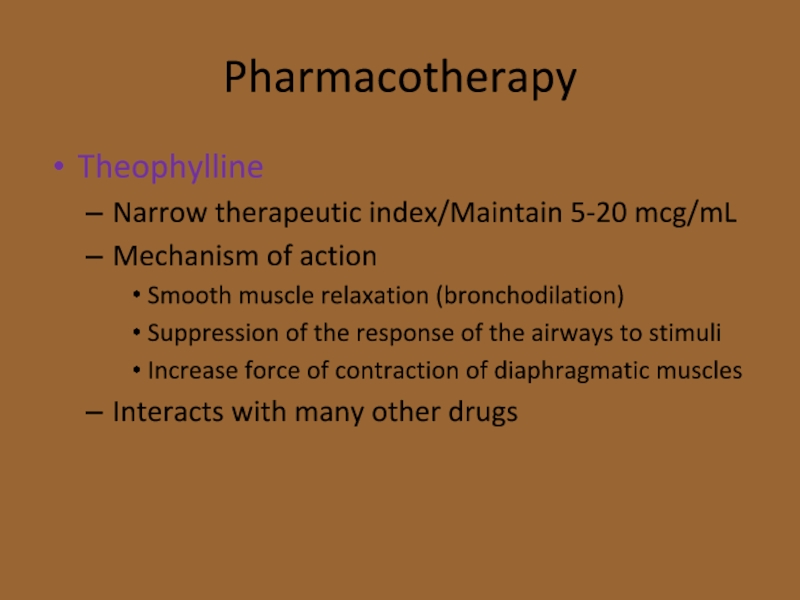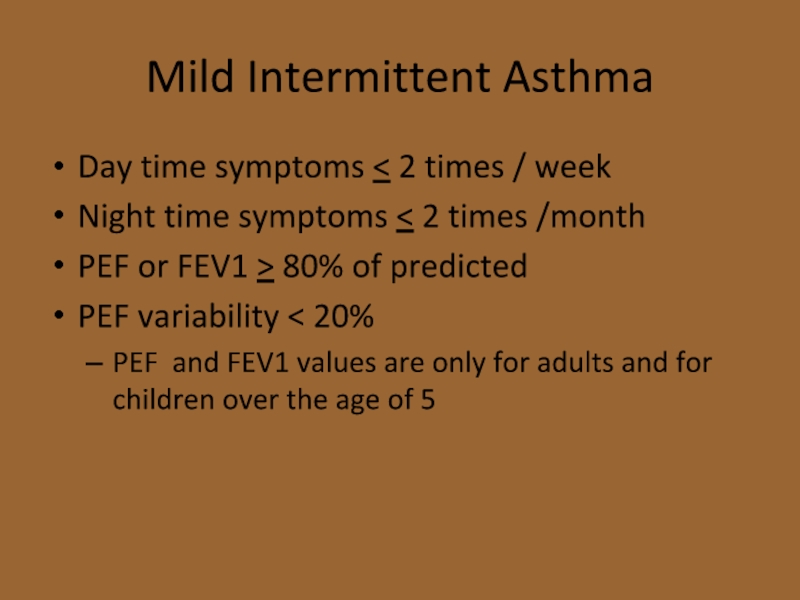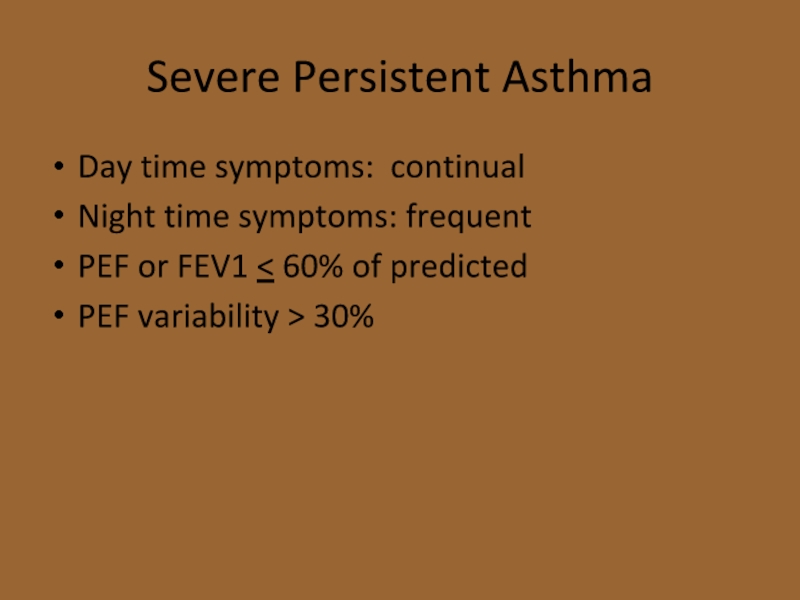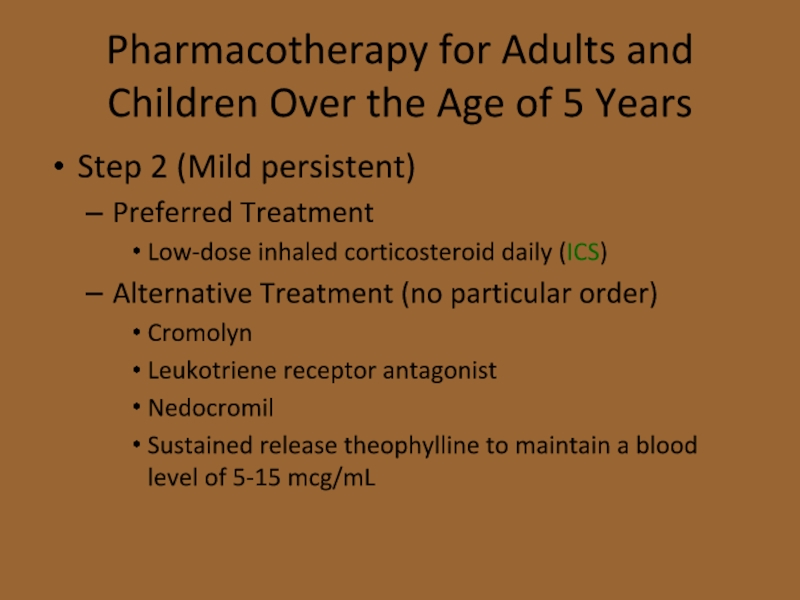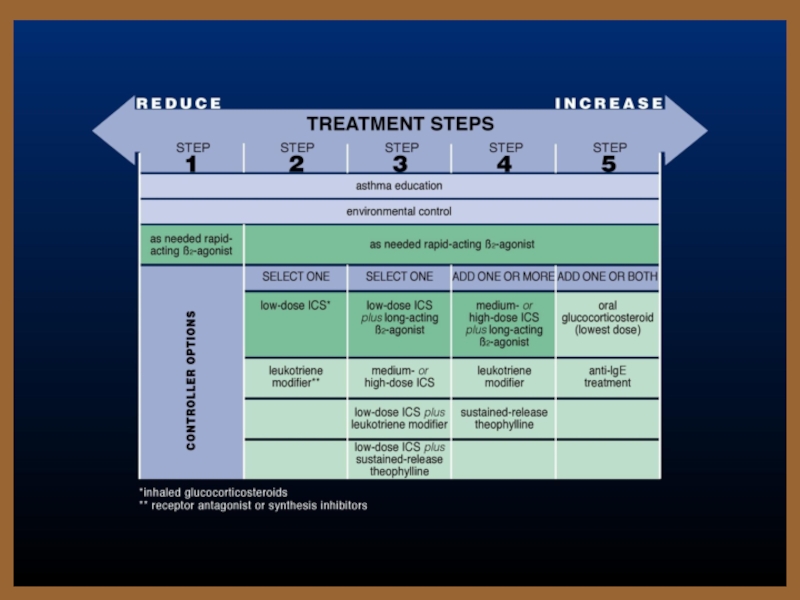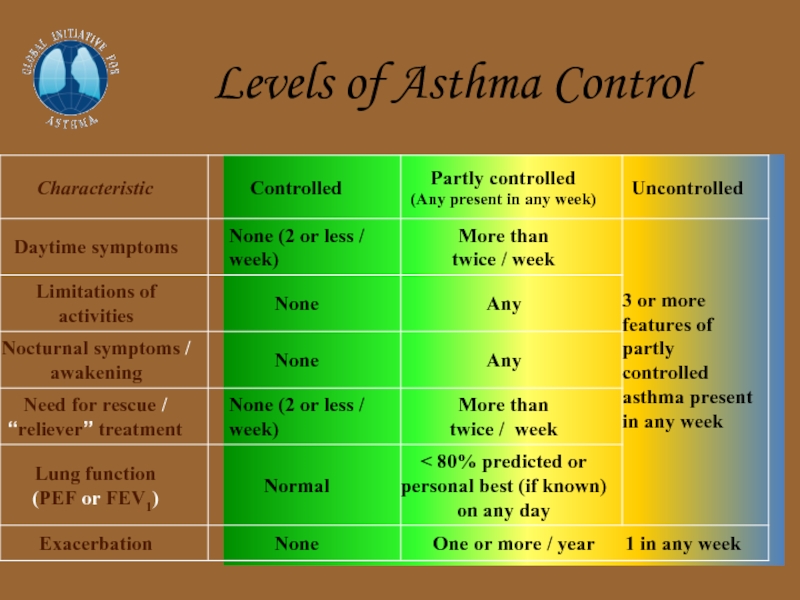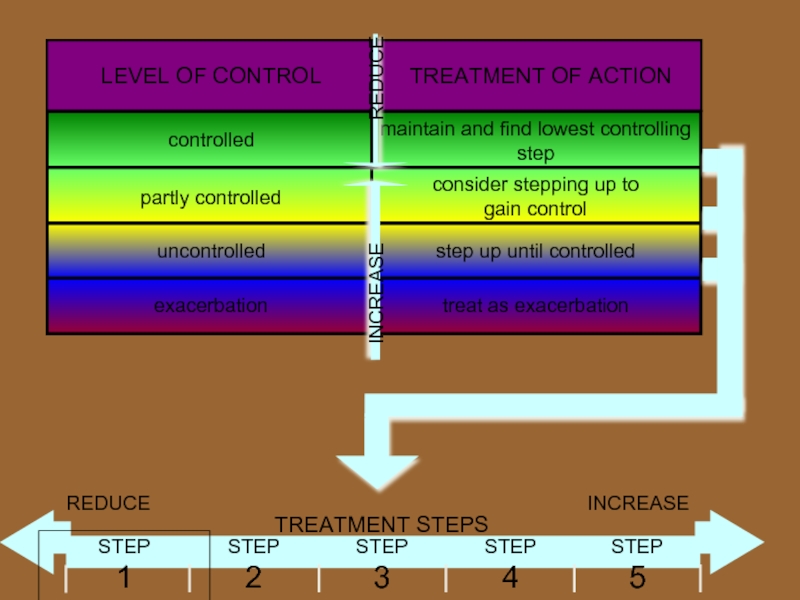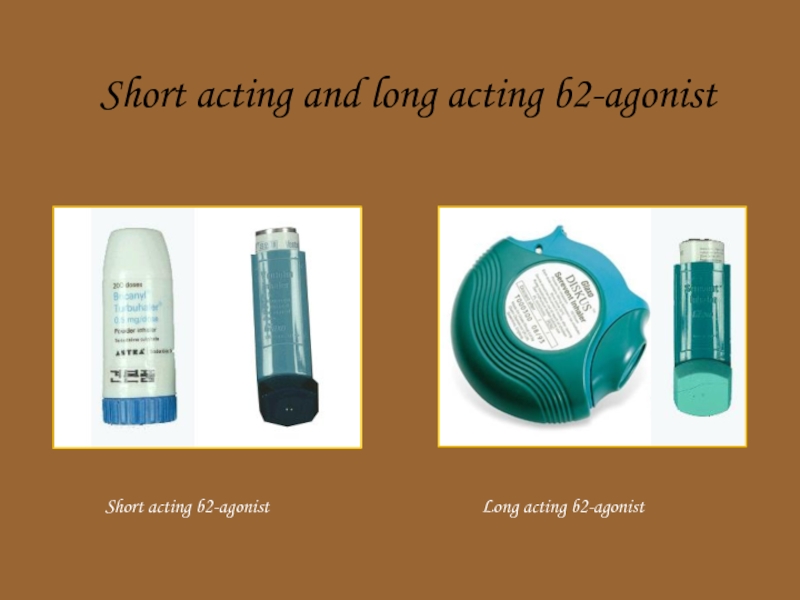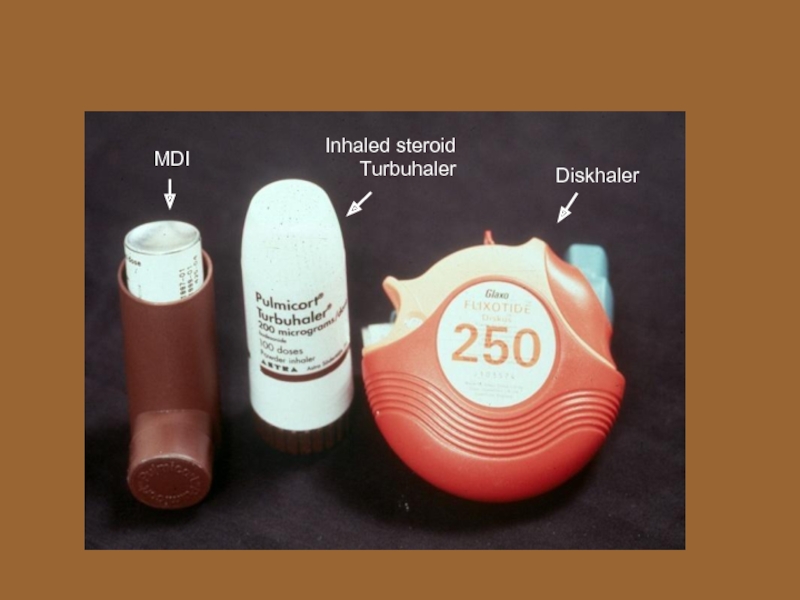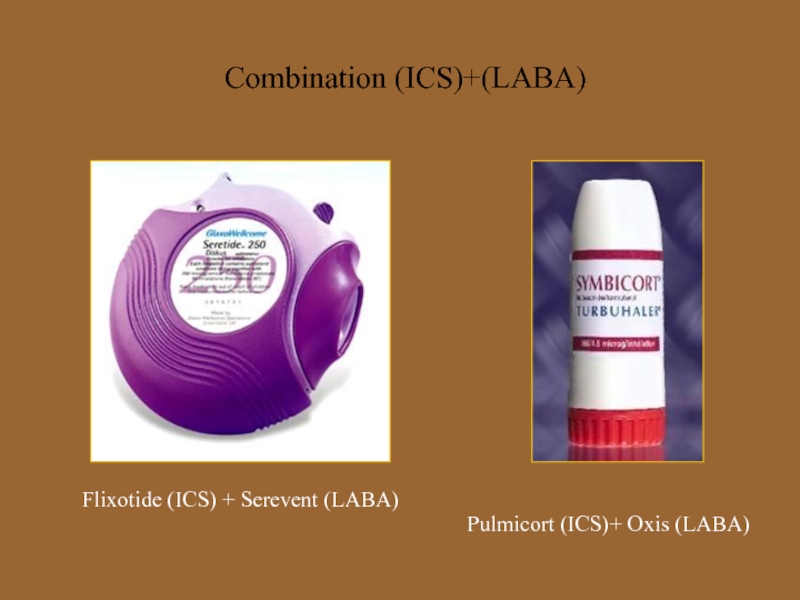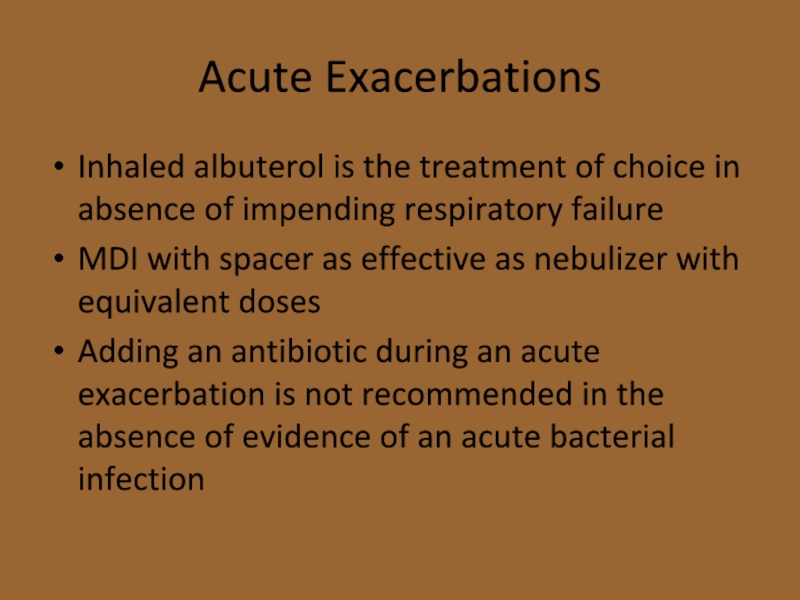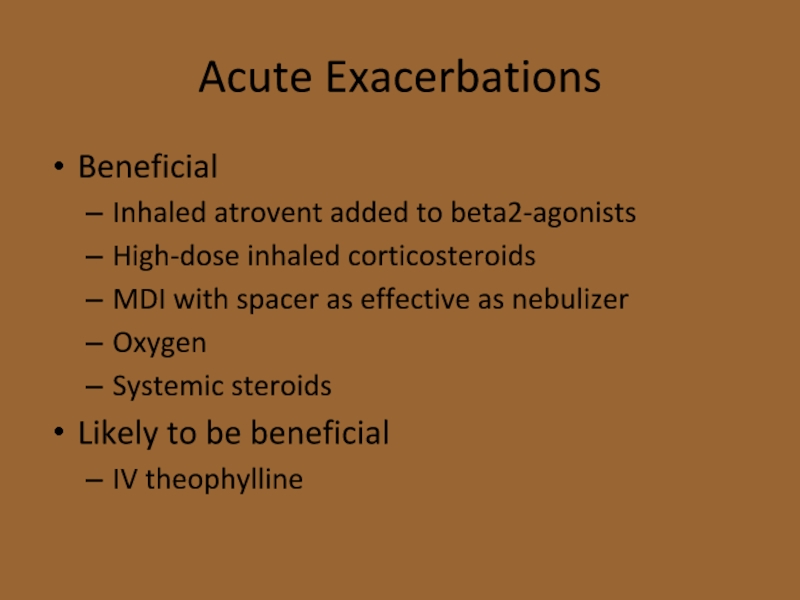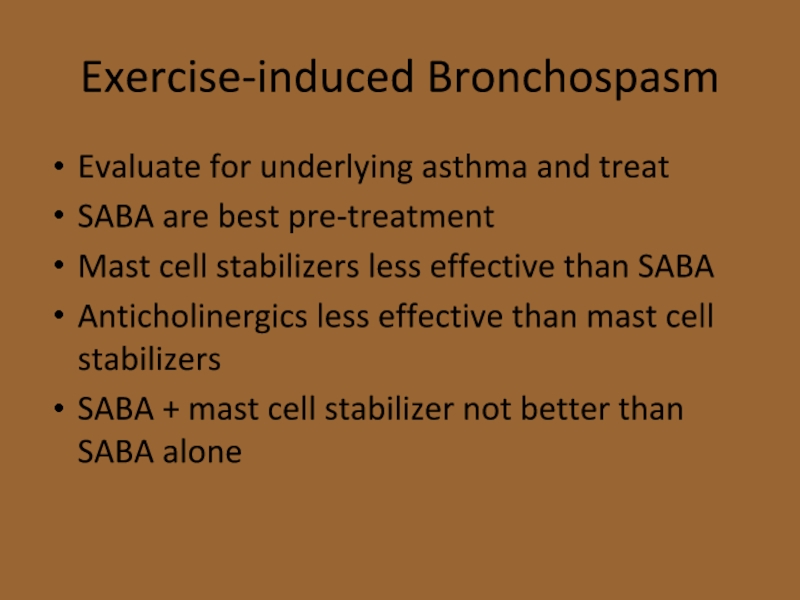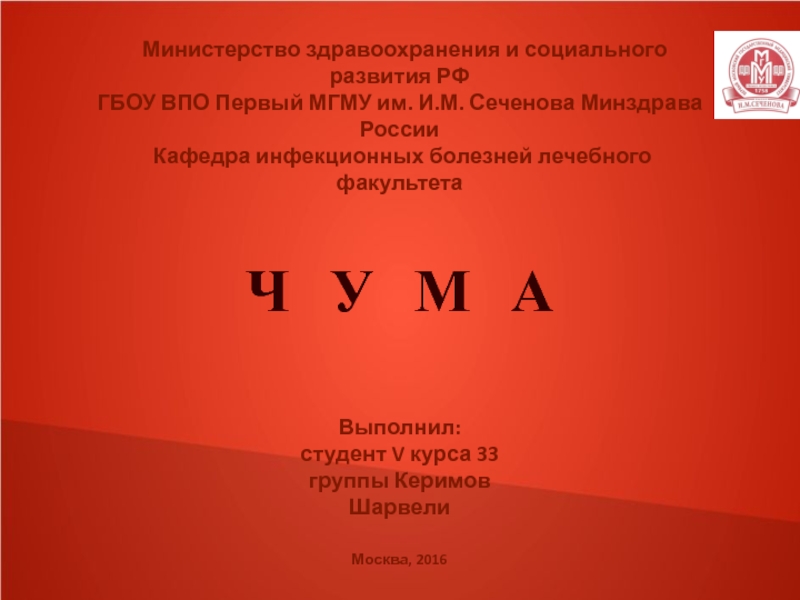- Главная
- Разное
- Дизайн
- Бизнес и предпринимательство
- Аналитика
- Образование
- Развлечения
- Красота и здоровье
- Финансы
- Государство
- Путешествия
- Спорт
- Недвижимость
- Армия
- Графика
- Культурология
- Еда и кулинария
- Лингвистика
- Английский язык
- Астрономия
- Алгебра
- Биология
- География
- Детские презентации
- Информатика
- История
- Литература
- Маркетинг
- Математика
- Медицина
- Менеджмент
- Музыка
- МХК
- Немецкий язык
- ОБЖ
- Обществознание
- Окружающий мир
- Педагогика
- Русский язык
- Технология
- Физика
- Философия
- Химия
- Шаблоны, картинки для презентаций
- Экология
- Экономика
- Юриспруденция
Bronchial asthma презентация
Содержание
- 1. Bronchial asthma
- 2. 1. ASTHMA Asthma is a chronic inflammatory
- 3. Asthma Usually associated with airflow obstruction of
- 4. BURDEN OF ILLNESS Significant cause of
- 5. Asthma Triggers Early childhood caused by viral
- 6. May predispose to asthma Childhood infections,
- 7. May protect against asthma Living on
- 8. Mechanisms: Asthma Inflammation
- 9. ASTHMA : PATHOLOGY
- 10. House dust mites Moldes … fongus Furnishing ( pillows , mattress ,carpets ,
- 11. PETS People allergic to pets should
- 12. Early ( 15-30 minutes) Late (
- 13. Acute severe asthma • PEF 33–50%
- 14. Life-threatening features • PEF < 33%
- 15. Diagnostic Testing Complete blood count Chest
- 16. PEAK FLOW METER Diagnosis of ASTHMA or
- 17. Diagnostic Testing Spirometry Recommended to do spirometry
- 18. Diagnostic Testing Spirometry Can be used to
- 20. Normal Flow-Volume Loop
- 21. Flow-Volume Loop in disease Mild reversible obstruc
- 22. Diagnostic Testing Methacholine challenge Most common bronchoprovocative
- 23. Diagnostic testing Diagnostic trial of anti-inflammatory medication
- 24. Goals of Asthma Treatment Control chronic and
- 25. Pharmacotherapy Albuterol (salbutamol) Short-acting beta2-agonist ATP to
- 26. Pharmacotherapy Long-acting beta2-agonists (LABA) Beta2-receptors are the
- 27. Pharmacotherapy Long-acting beta2-agonists (LABA) Salmeterol (Serevent) ,
- 28. Pharmacotherapy Inhaled Corticosteroids Anti-inflammatory Act locally
- 29. Pharmacotherapy Mast cell stabilizers (cromolyn /nedocromil) Inhibits
- 30. Pharmacotherapy Leukotriene receptor antagonists Leukotriene - mediated
- 31. Pharmacotherapy Theophylline Narrow therapeutic index/Maintain 5-20 mcg/mL
- 32. Various severities of asthma Step-wise pharmacotherapy treatment
- 33. Mild Intermittent Asthma Day time symptoms <
- 34. Mild Persistent Asthma Day time symptoms >
- 35. Moderate Persistent Asthma Day time symptoms q
- 36. Severe Persistent Asthma Day time symptoms: continual
- 37. Pharmacotherapy for Adults and Children Over the
- 38. Pharmacotherapy for Adults and Children Over the
- 39. Pharmacotherapy for Adults and Children Over the
- 40. Pharmacotherapy for Adults and Children Over the
- 42. Levels of Asthma Control
- 44. Short acting and long acting b2-agonist Long acting b2-agonist Short acting b2-agonist
- 46. Combination (ICS)+(LABA) Flixotide (ICS) + Serevent (LABA) Pulmicort (ICS)+ Oxis (LABA)
- 47. Acute Exacerbations Inhaled albuterol is the treatment
- 48. Acute Exacerbations Beneficial Inhaled atrovent added to
- 49. Exercise-induced Bronchospasm Evaluate for underlying asthma and
- 50. THANK YOU QUESTIONS ?? Dr yazied GH 0796518701
Слайд 1BRONCHIAL ASTHMA
Concerning bronchial asthma in children all of the following is
A. Common disorder in children
B. Usually precipitated by viral infections in the toddler age group
C. Is characterized by alveolar collapse
D. Is common at night
E. Broncho- spasm may be precipitated by house dust or mite in
the bed clothes
Слайд 21. ASTHMA
Asthma is a chronic inflammatory disorder of
airways with
. Many cells and mediators are involved in this process – eosinophils, mast cells and
T-lymphocytes. Chronic inflammation is associated with bronchial hyperresponsivness and leads to
episodes of wheezing, coughing, tightness in the
chest, breathlessness, shortage of breath specially at night and in the morning. This episodes are
usually associated with variable obstruction which is reversible spontaneously or by treatment.
Слайд 3Asthma
Usually associated with airflow obstruction of variable severity.
Airflow obstruction is usually
The inflammation associated with asthma causes an increase in the baseline bronchial hyperresponsiveness to a variety of stimuli
Слайд 4BURDEN OF ILLNESS
Significant cause of school/work absence.
Health care expenditures very high.
Morbidity
Слайд 5Asthma Triggers
Early childhood caused by viral
Late by :
Allergens
Dust mites, pollen, indoor
Pharmacologic agents (ASA, beta-blockers)
Physical triggers (exercise, cold air)
Physiologic factors
Stress, GERD, viral and bacterial URI, rhinitis
Слайд 6
May predispose to asthma
Childhood infections,
e.g. respiratory syncytial virus
Allergen exposure, e.g. house
dust
Indoor pollution
Dietary deficiency of antioxidants
Exposure to pets in early life
Слайд 7
May protect against asthma
Living on farm
Large families
Childhood infections,
including parasites
Predominance of
lactobacilli in
Exposure to pets in early life
Слайд 11PETS
People allergic to pets should not have them in the
At a minimum, do not allow pets in the bedroom.
Слайд 12
Early ( 15-30 minutes)
Late ( 4-12 houres)
Clinical presintation:
Diffuse wheezing expiratory then
Prolong expiratory phase
Dcreased breath sounds
Rhochia / rales
Most common symptom ,,,,, cough
Слайд 13
Acute severe asthma
• PEF 33–50% predicted (< 200 L/min)
Increase in resipartory
Tachycardia
• Inability to complete sentences in 1 breath
Слайд 14
Life-threatening features
• PEF < 33% predicted (< 100 L/min)
• SpO2
treated with oxygen)
• Normal or raised PaCO2
• Silent chest
• Cyanosis
• Feeble respiratory effort
• Bradycardia or arrhythmias
• Hypotension
• Exhaustion
• Confusion
• Coma
Near-fatal asthma
• Raised PaCO2 and/or requiring mechanical ventilation with
raised inflation pressures
Слайд 15Diagnostic Testing
Complete blood count
Chest x ray ,,,, hyperinflation chest
IgE
Sinus xray not routinely used
Gold stander spirometry
FEV1/FVC < 80%
Bronchodilator ,,,, > 12%
Exercise ,,,,,, < 15%
Peak expiratory flow (PEF) ….. < 20 %
Inexpensive
Patients can use at home
May be helpful for patients with severe disease to monitor their change from baseline every day
Not recommended for all patients with mild or moderate disease to use every day at home
Effort and technique dependent
Should not be used to make diagnosis of asthma
Слайд 16PEAK FLOW METER
Diagnosis of ASTHMA or COPD can be
confirmed by demonstrating
of airway obstruction using Spirometry.
Слайд 17Diagnostic Testing
Spirometry
Recommended to do spirometry pre- and post- use of an
> 12% reversibility and an increase in FEV1 of 200cc is considered significant
Obstructive pattern: reduced FEV1/FVC ratio
Restrictive pattern: reduced FVC with a normal FEV1/FVC ratio
Слайд 18Diagnostic Testing
Spirometry
Can be used to identify reversible airway obstruction due to
Can diagnose Exercise-induced asthma (EIA) or Exercise-induced bronchospasm (EIB) by measuring FEV1/FVC before exercise and immediately following exercise, then for 5-10 minute intervals over the next 20-30 minutes looking for post-exercise bronchoconstriction
Слайд 21Flow-Volume Loop in disease
Mild reversible obstruc
Severe irreversible obstr
Severe restrictive dis
ASTHMA
COPD
ILD
Слайд 22Diagnostic Testing
Methacholine challenge
Most common bronchoprovocative test
Patients breathe in increasing amounts of
Increased airway hyperresponsiveness is established with a 20% or more decrease in FEV1 from baseline at a concentration < 8mg/dl
May miss some cases of exercise-induced asthma
Слайд 23Diagnostic testing
Diagnostic trial of anti-inflammatory medication (preferably corticosteroids) or an inhaled
Especially helpful in very young children unable to cooperate with other diagnostic testing
There is no one single test or measure that can definitively be used to diagnose asthma in every patient
Слайд 24Goals of Asthma Treatment
Control chronic and nocturnal symptoms
Maintain normal activity, including
Prevent acute episodes of asthma
Minimize ER visits and hospitalizations
Minimize need for reliever medications
Maintain near-normal pulmonary function
Avoid adverse effects of asthma medications
Слайд 25Pharmacotherapy
Albuterol (salbutamol)
Short-acting beta2-agonist
ATP to cAMP leads to relaxation of bronchial smooth
To prevent exercise bronchial asthma
Should be used prn not on a regular schedule
Prior to exercise or known exposure to triggers
Up to every 4 hours during acute exacerbation
Most effective inhaler rather than orally
Слайд 26Pharmacotherapy
Long-acting beta2-agonists (LABA)
Beta2-receptors are the predominant receptors in bronchial smooth muscle
Stimulate
Inhibits release of mast cell mediators such as histamine, leukotrienes, and prostaglandin-D2
Beta1-receptors are predominant receptors in heart, beta2-receptors
Слайд 27Pharmacotherapy
Long-acting beta2-agonists (LABA)
Salmeterol (Serevent) , formoterol
Salmeterol with fluticasone (seritide)
Formoterol with
Should only be used as an additional treatment when patients are not adequately controlled with inhaled corticosteroids
Should not be used as rescue medication
Слайд 28Pharmacotherapy
Inhaled Corticosteroids
Anti-inflammatory
Act locally in lungs
Some systemic absorption
Risks of possible
Not intended to be used as rescue medication
Benefits may not be fully realized for 1-2 weeks
Preferred treatment in persistent asthma
Слайд 29Pharmacotherapy
Mast cell stabilizers (cromolyn /nedocromil)
Inhibits release of mediators from mast cells
Blocks Ca2+ ions from entering the mast cell
Safe for pediatrics (including infants)
Should be started 2-4 weeks before allergy season when symptoms are expected to be effective
Can be used before exercise
Слайд 30Pharmacotherapy
Leukotriene receptor antagonists
Leukotriene - mediated effects include:
Airway edema
Smooth muscle contraction
Altered cellular
Receptors have been found in airway smooth muscle cells and macrophages and on other pro-inflammatory cells (including eosinophils and certain myeloid stem cells) and nasal mucosa
Слайд 31Pharmacotherapy
Theophylline
Narrow therapeutic index/Maintain 5-20 mcg/mL
Mechanism of action
Smooth muscle relaxation (bronchodilation)
Suppression of
Increase force of contraction of diaphragmatic muscles
Interacts with many other drugs
Слайд 32Various severities of asthma
Step-wise pharmacotherapy treatment program for varying severities of
Mild Intermittent (Step 1)
Mild Persistent (Step 2)
Moderate Persistent (Step 3)
Severe Persistent (Step 4)
Patient fits into the highest category that they meet one of the criteria for
Слайд 33Mild Intermittent Asthma
Day time symptoms < 2 times / week
Night time
PEF or FEV1 > 80% of predicted
PEF variability < 20%
PEF and FEV1 values are only for adults and for children over the age of 5
Слайд 34Mild Persistent Asthma
Day time symptoms > 2/week, but < 1/day
Night time
PEF or FEV1 > 80% of predicted
PEF variability 20%-30%
Слайд 35Moderate Persistent Asthma
Day time symptoms q day
Night time symptoms > 1
PEF or FEV1 60%-80% of predicted
PEF variability >30%
Слайд 36Severe Persistent Asthma
Day time symptoms: continual
Night time symptoms: frequent
PEF or FEV1
PEF variability > 30%
Слайд 37Pharmacotherapy for Adults and Children Over the Age of 5 Years
Step 1 (Mild intermittent asthma)
No daily medication needed
PRN short-acting bronchodilator (SABA) MDI
Severe exacerbations may require systemic corticosteroids
Although the overall diagnosis is “mild intermittent” the exacerbations themselves can still be severe
Слайд 38Pharmacotherapy for Adults and Children Over the Age of 5 Years
Step
Preferred Treatment
Low-dose inhaled corticosteroid daily (ICS)
Alternative Treatment (no particular order)
Cromolyn
Leukotriene receptor antagonist
Nedocromil
Sustained release theophylline to maintain a blood level of 5-15 mcg/mL
Слайд 39Pharmacotherapy for Adults and Children Over the Age of 5 Years
Step
Preferred Treatment
Low-to-medium dose inhaled corticosteroids (ICS)
WITH long-acting inhaled beta2-agonist (LABA)
Alternative Treatment
Increase inhaled corticosteroids within the medium dose range
Add leukotriene receptor antagonist or theophylline to the inhaled corticosteroid
Слайд 40Pharmacotherapy for Adults and Children Over the Age of 5 Years
Step
Preferred Treatment
High-dose inhaled corticosteroids
AND long-acting inhaled beta2-agonists
AND (if needed) oral corticosteroids
IV fluid
Miost tent not used
Слайд 47Acute Exacerbations
Inhaled albuterol is the treatment of choice in absence of
MDI with spacer as effective as nebulizer with equivalent doses
Adding an antibiotic during an acute exacerbation is not recommended in the absence of evidence of an acute bacterial infection
Слайд 48Acute Exacerbations
Beneficial
Inhaled atrovent added to beta2-agonists
High-dose inhaled corticosteroids
MDI with spacer as
Oxygen
Systemic steroids
Likely to be beneficial
IV theophylline
Слайд 49Exercise-induced Bronchospasm
Evaluate for underlying asthma and treat
SABA are best pre-treatment
Mast
Anticholinergics less effective than mast cell stabilizers
SABA + mast cell stabilizer not better than SABA alone
